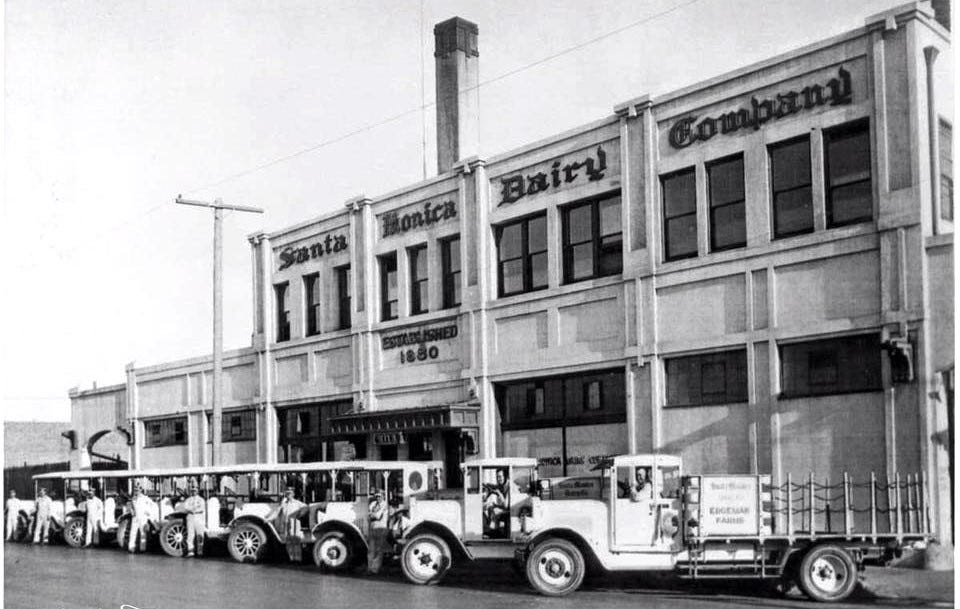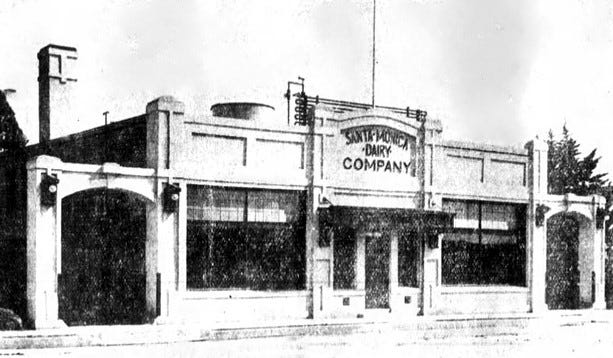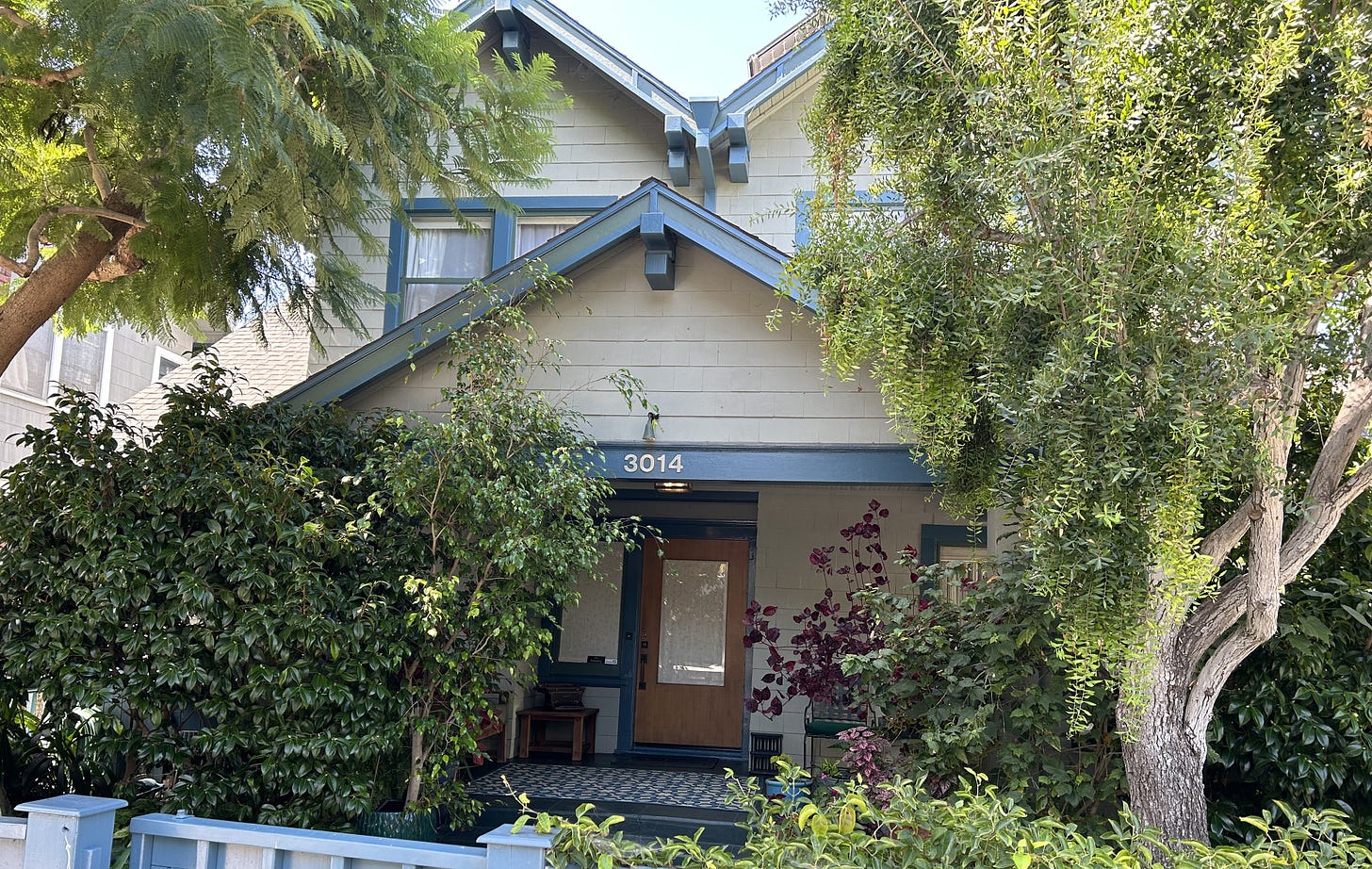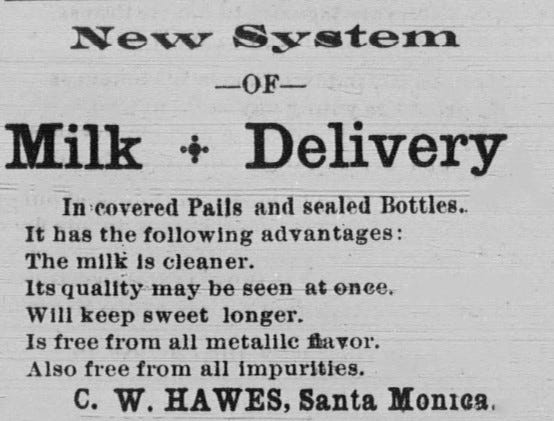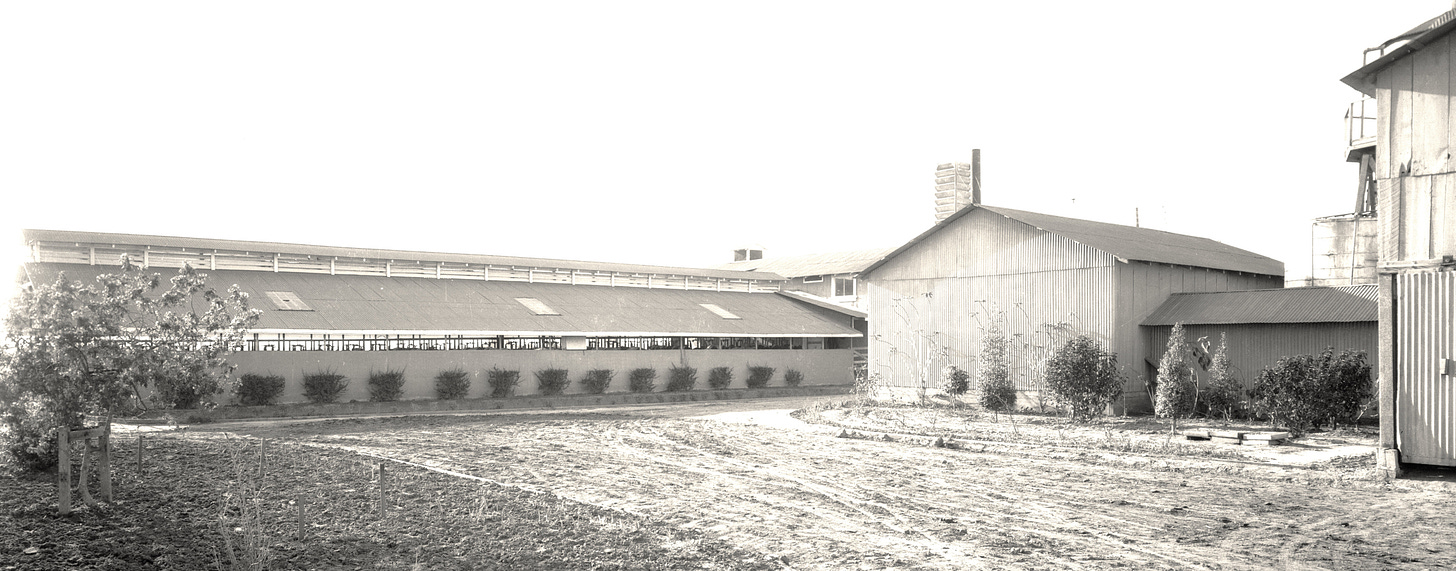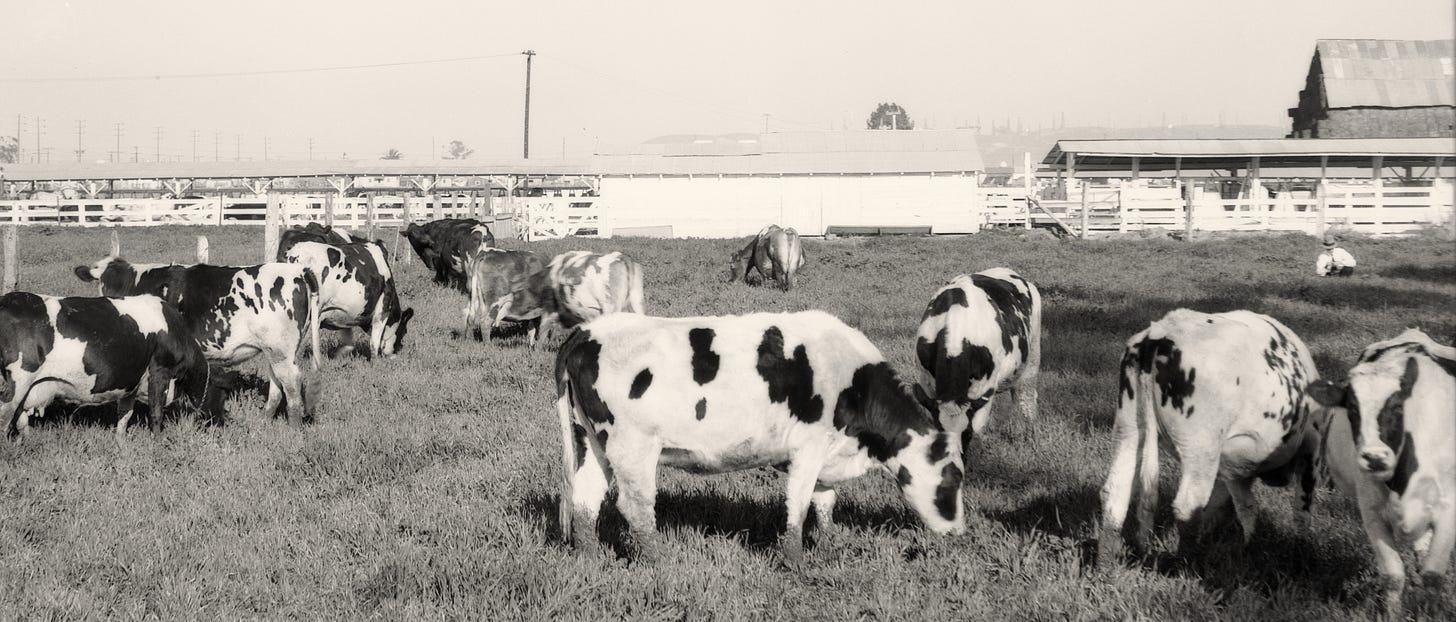Well, we have to go out of Ocean Park again - back across the border into Venice - to have a look at the Venice-based Santa Monica Dairy Company.
In 1893 Swiss immigrant Herman Michel (1872 – 1969)1 buys Charles Hawes (1852 – 1901)2 Santa Monica dairy3 at 17th and Santa Monica. In 1895, Michel and fellow Swiss immigrant Ruldoph Hiltbrand (1863 – 1945)4 form the Santa Monica Dairy Company as an unincorporated partnership.5
The cows graze on pasture in Kenter Canyon. In 1903, as the business grows, Santa Monica Dairy moves to the Rose ranch on Rancho La Ballona. When the Rose ranch is sold in 1905, Michel buys a 176-acre portion east of Lincoln near Marina Del Rey called Edgemar.6
With the acquisition of the downtown Los Angeles Imperial Dairy7 in 1907, Santa Monica Dairy has a herd of 80 cows and a practical monopoly on the milk business along the beach. In 1914, Santa Monica Dairy builds a milk processing dairy plant in Venice on Rose Ave (between 3rd and 4th Ave).
Since 1908, Santa Monica Dairy is pasteurizing milk at the Imperial Ice Company plant at 2435 Main St. in Ocean Park - Michel is president of both companies. In 1914, all Santa Monica Dairy operations move to the new Rose Ave plant. The milk comes from almost 400 cows fed on alfalfa at the Edgemar Farm. In 1916, Michel dissolves the partnership with Hiltbrand.
By 1923, Santa Monica Dairy is producing 2,000 gallons of milk per day, distributed by 25 wagons and trucks. In 1926 Santa Monica Dairy builds a branch milk processing plant in Beverly Hills.8 In 1928, Santa Monica Dairy begins using the Edgemar Farms trademark. In 1930 Santa Monica Dairy celebrates 50 years.9 In 1943 the Rose Ave plant is enlarged and modernized.
With the end of WWII, Santa Monica Dairy streamlines its operations. Michel sells his Edgemar Farm dairy herd in 1947, and imports 10,500 gallons of milk daily on tankers from the San Fernando Valley to the Rose Ave plant. The milk and other products10 are sold under the Edgemar and Edgemar Farms labels.
The Rose Ave Venice plant, run by Herman and his four sons (Clarence general manager, Walter sales manager, Ralph on site Edgemar Farm manager, and Howard managing butter and cheese operations in Grant’s Pass OR), employs 225 people - and in 1949 is the largest employer in Venice.
In 1984, the Michel Brothers sell the Santa Monica Dairy Company (now with annual sales of $20MM) to Foremost.11 The Rose Ave Venice plant ceases operations and the equipment is sold at auction.
Herman Michel (1872 – 1969) Born in Switzerland, Michel and his compatriot John Grossman (1868 – 1957) come to the US in 1888. They go to Santa Ana and then to Merced. In 1893 Michel buys out Charles Hawes’ Santa Monica dairy and in 1903 moves to the Edgemar farm east of Marina Del Rey. In 1920 Michel, president of Santa Monica Dairy and Imperial Ice, opens the Marine Bank of Ocean Park. In 1925 Michel defeats J.C. Steele in a Santa Monica recall election and serves two terms as Santa Monica mayor.
Michel and his wife, Nora Michel (1876 – 1959), live on the Edgemar Farm for 20 years, before moving in 1923 to 3014 3rd St. in Ocean Park, until his death in 1969.
Charles William Hawes (1852 – 1901) Born in Maine, Hawes comes to Santa Monica in 1876 and works as a carpenter. In 1877 his mother and brother (Albert D. Hawes) arrive from Maine, and they live in a cottage that Hawes has built. In 1889 Hawes opens a California curiosities store opposite the S&P train depot. In 1891 Hawes starts a dairy at 17th and Santa Monica Blvd with 45 cows and milk delivery. In 1893 Hawes sells the dairy operation to Herman Michel.
The first cattle brought into California are scrawny stock from Mexico - used primarily for meat, hides, and tallow. Many who make the overland trek to California bring with them cows to provide milk for their families. Larger dairy herds first emerge close to California’s most populated areas. According to the 1860 census, there are 264,000 people in California and 104,000 cows. During the 1880s and 1890s dairying in California is transformed from a provincial industry to a scientific and modern one - with the introduction of the cream separator, refrigeration, irrigation, the milking machine, and extensive planting of alfalfa. The glass milk bottle with reliable closure is invented in 1886. In 1907, pasteurized milk becomes commercially practical.
Ruldoph Hiltbrand (1863 – 1945). Born in Switzerland, comes to the US in 1881 and is naturalized in 1894 in Los Angeles. In 1895, Hiltbrand and fellow Swiss immigrant Herman Michel form the Santa Monica Dairy Company. In 1915 Hiltbrand marries Marcelle Delacourt Berkelmans (1873 – 19??). She dies before 1920, and he marries Swiss-born Julia Hiltbrand (1888 – 19??).
In 1910, Frederick Henry Pahl (1876 - 19??), a Venice dairyman, incorporates with the Secretary of State under the name Santa Monica Dairy Company, Incorporated, and proceeds to distribute milk products under this name. The courts quickly find that incorporation does not give Pahl any rights to use the trademarked Santa Monica Dairy name.
Edgemar Farm east of Marina Del Rey was once part of the Anderson Rose ranch.
When Michel sells his Edgemar Farm herd in 1947, the property is used for growing animal feed.
In 1950, Santa Monica Dairy’s 176-acre Edgemar property, located in unincorporated Los Angeles County, is rezoned and developed for industrial use. The industrial development halts when Los Angeles County rezones the remaining property back to agricultural use.
In 1958 Santa Monica Dairy convinces Los Angeles City to annex the Edgemar property and rezone it light industrial - with higher tax revenues. In 1967, Los Angeles City rezones the remaining property back to agricultural use. Santa Monica Dairy’s last 80 acres becomes the Marina Golf Course. In 1971, Santa Monica Dairy sells the golf course property for residential and retail development.
Imperial Dairy, located at 7th & San Julian in downtown Los Angeles, is owned by A.E. Beane and C.F Smith. In 1903, Bingham Creamery at the same location is implicated in supplying contaminated milk. In 1905, Alton E. Beane and John D. Blanchard, who are associated with the Imperial Dairy, form the Imperial Ice Company on Main St. in Ocean Park.
The 1926 Beverly Hills branch plant is at the corner of Alden and Foothill. The plant is designed by Santa Monica Dairy general manager W. H. Jackson (1883 - 1949) and features a replica milk bottle on the office roof. There is a 2-story stable and hay barn - which burns in 1933.
The 1880 date is in blue letters on the front of the Santa Monica Dairy buildings. The basis for this date is tenuous. Brothers Burton and George Platt, from Waterbury, Connecticut, have a better claim for the first Los Angeles dairy business in 1884.
The EDGEMAR® trademark registration covers the categories of cream; sour cream; half and half; fluid milk; whipping cream; flavored ice milk mixes; chocolate drinks; buttermilk; cottage cheese; and fresh eggs.
Foremost Dairy begins in Florida in 1929 as a project of J.C. Penney (yes that J.C. Penny) - Foremost is the name of his prized bull, Langwater Foremost. By the 1950s, Foremost is a nationwide dairy.
In 1986 Knudsen undertakes a $168 million leveraged buyout of Foremost. In 1987 Knudsen files for Chapter 11 under the US Bankruptcy Code. In 1988 Knudsen sues Citicorp claiming that Citicorp knew Knudsen would go bankrupt after the Foremost leveraged buyout, and shouldn’t have lent Knudsen the money.
In 1987 Public Storage buys the Rose Ave dairy plant property.



